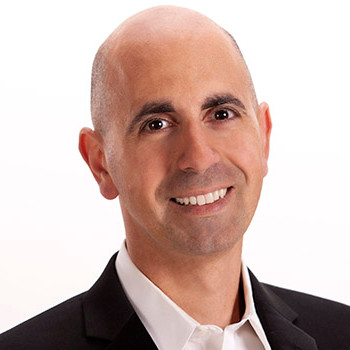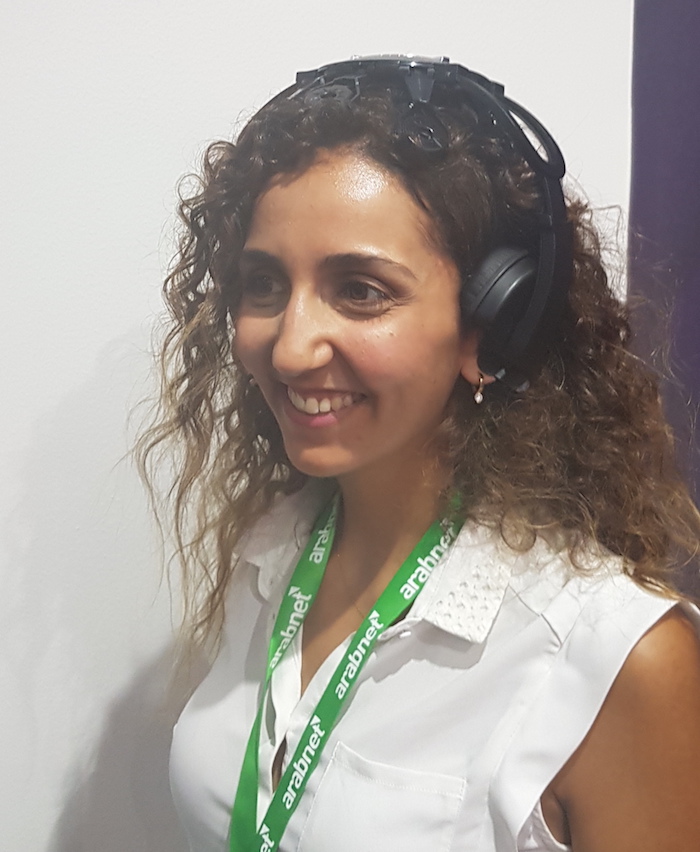The brain is the most complex organ in the human body. It produces emotions, thoughts, memories and reactions, weighs around 1.4 kilograms and contains around 100 billion neurons or nerve cells.
The complexity of these cells is staggering. Each neuron makes contact with tens of thousands of other cells and our brains can form a million new connections each second.
With a PhD in Neuroscience from the University of Southern California (USC), LebNet member Walid Soussou works on Brain-Computer-Interfaces to develop new wearable sensor technologies for commercial applications.
During an event in Beirut, we met with Soussou and talked about his company Wearable Sensing – which uses non-invasive techniques to monitor brain activities – the complexities of developing such wearable technologies and the most popular applications. We also had the chance to test their virtual reality headset, which monitors brain activity while screening 3D visuals for patients to enjoy. Read our interview with him below:
How do you describe Wearable Sensing?
Wearable Sensing is a company that develops, manufactures, markets and sells wearable sensors for research and professional applications.
We are currently focusing on wearable brain monitoring, as we have developed a revolutionary technology that allows us to record high-quality signals from the brain in a practical and non-invasive fashion, which allows brain monitoring outside of the confines of laboratories or specialized medical centers. The brain signals we record are called Electroencephalograms (EEG), and they represent the electrical activity of neurons as measured from the scalp (the surface of the head).

Walid Soussou (Image via LinkedIn)
Conventional EEG requires skin abrasion (a painful process of rubbing the dead cell layers, much like an old-style Hammam scrubbing!) and the application of gooey gels and a painstaking process of attaching electrodes to the head and plugging them into large equipment. What is revolutionary about our technology is that we use dry electrodes that do not require skin abrasion or gels and that are built into easy-to-use, comfortable and wireless headsets. This makes the entire process of setting up and collecting brain data achievable with minimal training. Of course, we take great pride that this simplification of use does not compromise the signal quality, making our devices still very useful for delivering high-quality brain signals in real-world settings. We have 6 principal products on the market and their peripherals, which we distribute through a global distribution network spanning 37 countries.
The products sound revolutionary and provides much better alternatives. What type of audience would benefit from them?
We currently sell our products to researchers in diverse fields ranging from neuroscience and psychology to marketing, education, and computer game development. The brain provides a rich set of data from which these researchers extract insight into our cognitive states (such as attention, memory, effort), brain health (such as depression, ADHD, autism), emotions (desires, fears, enjoyment, arousal) and which they use to understand the brain or to develop useful applications.
We also sell our products to a subset of medical professionals who use it to conduct neurofeedback training, which is a type of non-pharmacological brain therapy that can be used for rehabilitation (after stroke, depression, ADHD, concussion) or for peak-performance augmentation (such as enhancing memory, focus, acuity).
Furthermore, we collaborate and partner with businesses and companies to develop custom hardware for their specific applications, such as sleep enhancement, stroke rehabilitation, neuromarketing, gaming in virtual reality and more.
The areas you’re tapping into directly impact people’s lives. Can you give us more specific examples on products helping people live better?
There is a wide range of neuro-applications that could be useful and desirable to society, that is currently not possible due to a gap in brain monitoring technology. Current mainstream brain monitoring is either very expensive, difficult, tedious, and invasive, or produces low-quality brain signals that are not really usable for most applications. Our technology fills this gap by providing easy-to-use yet high-quality brain monitoring that can be done in real-world settings.
We are already working on the following applications with some of our partners: using brain signals to control computers, prosthetic limbs or robots; using brain signals tocontrol computer games; using brain signals recorded while shoppers walk in a supermarket to determine which products appeal to which consumers; using brain signals to enhance learning outcomes; using brain signals to improve brain function, to improve airport security, to improve artificial intelligence, to teach meditation, to screen for autism, etc. All of these and more are applications we are working to bring out with our partners.

Reine Farhat, LebNet’s Communications Specialist, testing Wearable Sensing’s headset after her interview with Walid Soussou at ArabNet Beirut event.
Why did you pick this area of work?
As an undergraduate student, I transitioned from a French educational system to an English system and found myself reading frustratingly slowly! I wished I could download books into my brain directly. I later heard of researchers at the University of Southern California (USC) working on brain Implants. This was in 1994, way before the current brain implant frenzy. So I applied to USC for graduate school and joined that lab, only to realize that this was a long-term mission and that I would be working on dissected brains and cell cultures for many years before there would be any human trials and books to download. After my post-doctoral fellowship, I decided to venture out of academic research into applied science that could directly benefit humans. I knew nothing about starting a company, had no funds, or business plan, I just reached out to a company that had just developed the right kind of non-invasive sensor that my project would have needed. They offered me a job, lab and office space, and access to the team and technology. So on my first day as an entrepreneur, I sold out and took the job! And I am very glad I did as I have learned so much about how to develop products from concepts, how to fund and manage research towards commercialization, how to keep a sustainable company alive, how to start a new one, and how to evaluate business opportunities. And in the process, I have been very fortunate to be developing applications for brain monitoring that are finally reaching market readiness, which was my ultimate goal.
You operate in a capital-intensive industry. How are you sustaining your business financially?
We have two companies that work together in synergy:
1-QUASAR is an R&D company that is funded by research grants from the US government to develop new technologies. This non-dilutive funding allows us to keep innovating and developing cutting edge technology. We have raised over $28M over the past 20 years to develop our technology to where it is today. QUASAR licenses its technology to other companies to commercialize.
2-Wearable Sensing is a company that has an exclusive license on QUASAR’s EEG sensor technology and manufactures and sells these products globally. It is funded solely through its sales. We are now raising VC funding to accelerate our growth and bring out some of our next-generation products faster to the market.
QUASAR and Wearable Sensing share a team of 20 people, who are a mix of scientists, engineers, technicians and administrative personnel.
Your technology is very complex. Can you walk us through the manufacturing process?
Our products have both high-end electronic components and complex mechanical structures, which mandates tedious management of suppliers and inventory, careful assembly and extensive testing during manufacturing. Our team has developed procedures to manufacture these products at the small scales that our current market requires. As part of our growth, we plan to re-engineer our products to allow us to scale up manufacturing.
How important it is to be passionate about the field you’re involved in?
You have to face so many challenges every day of running a business, in everything from operations, to competition, to customers, to regulatory, to team members, etc., that the only way not to give up, is to be passionate about what you do. So that whenever you stop and ask yourself: “why am I doing this?” you can safely answer with this question: ” well, what would I rather be doing?”.
The more positive view is that work is most rewarding when it is in a field one is excited about and doing well at. Passion leads to a perseverant effort which hopefully yields excellence and success, which ultimately produces satisfaction and bolsters passion… For now, I’m still at the perseverant effort stage and hoping the rest will indeed follow. I’ll let you know how it goes!
